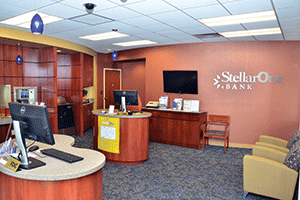Pruning the branch
As foot traffic falls, banks experiment with streamlined offices
Pruning the branch
As foot traffic falls, banks experiment with streamlined offices
StellarOne’s branch at Patterson and Libbie avenues
in Richmond looks more like a small hotel lobby
than a banking office.
When you enter the StellarOne bank branch at the corner of Patterson and Libbie avenues in Richmond, one thing quickly becomes apparent: There are no tellers and no line.
The branch looks more like a small hotel lobby with a concierge desk, a couple of comfy chairs and a pot of coffee brewing. Alongside the paneled left wall are what appears to be a few payphones with video screens. A customer walks up to the screen and pushes a button to have a video conference with a bank professional in a secure back room. The same bank representative can aid multiple customers simultaneously without noticeable service delays and can disburse money and handle complicated deposits and transactions.
As mobile and online banking increases, foot traffic at bank branches nationally is decreasing. That development is driving some banks to experiment with the bank branch model, in some cases creating streamlined offices with employees who are trained to do more than deposit checks and disburse cash.
“I think we need to recognize that younger people do not utilize bank branches to the extent that we older people do,” says StellarOne Chairman Raymond D. Smoot Jr. “My children seldom go into a bank branch. Being able to deliver services online is important. It used to be in order to do a CD, you had to go to the bank and sit down and fill out a bunch of forms, and now an increasing number of banks are doing CDs online. I think there will continue to be branches but the number of branches in banking … will be declining as the delivery of banking services over the Internet expands.” (Charlottesville-based StellarOne plans to merge with Richmond-based Union First Market. See related story on page 59.)
This spring in Washington, D.C., Wells Fargo debuted a pilot 1,250-square-foot mini-branch with tech-friendly ATM screens. Bank employees with tablets walk around to assist customers as needed.
“It’s not the branch that’s dead; it’s the workflow and the technology that needs to be reinvigorated,” says Jonathan Velline, of Wells Fargo’s national ATM and store strategies.
The new mini-branch is virtually paperless and requires just 10 percent back-office space as opposed to the 40 percent a regular bank branch might require, Velline says. It also allowed the bank to open a new branch in an urban neighborhood where real estate is at a premium.
Typically, bank branches are about 4,000 square feet and cost about $4 million to build. As banks seek cost-cutting measures, expensive, large branches are low-hanging fruit, experts say.
Given how hard it is to increase revenues in the current operating environment and economy, “everyone is focused on costs and they’re taking a hard look at their branch structures … from the big guys all the way down to the small banks,” says BB&T Equity Research Analyst Blair Brantley.
Creating more tech-savvy branches and offering more mobile and online banking options also is important to the growing millennial customer demographic, Velline notes.
Not everyone thinks technology is crucial, however. At Martinsville-based Carter Bank & Trust, foot traffic has been growing at its 123 bank branches. That’s because Carter Bank & Trust doesn’t offer online banking or ATMs. The bank is considering online banking, but its board has been hesitant because of cyber-crime fears.
“The risk to the bank of significant monetary loss is greater than we think we ought to absorb at this time,” says Worth Harris Carter Jr., the bank’s chairman and president “The bank has continued to grow and prosper, even though we have customers who want [online banking].”
While some once said that ATMs and debit cards would also spell death for the bank branch, it’s clear that “generationally, [technology is] going to have a very, very big impact on the whole conventional [bank] branch as we know it,” says David West, senior vice president at the Richmond investment firm Davenport & Co. “Studies are showing … that the younger the person, the more technology they use, the less they feel they need to go in and visit a physical branch. While it’s not going to go away overnight by a long shot … it’s very much going to impact the types of offices and branches banks use.”
l

















